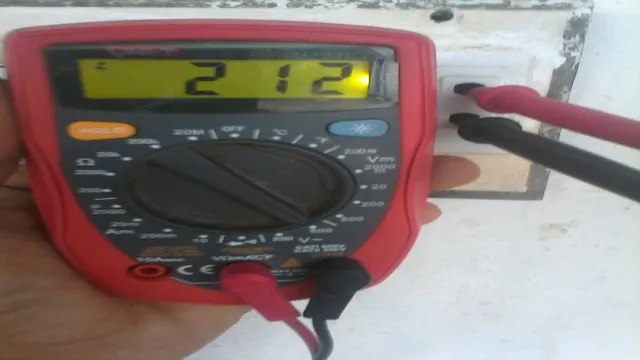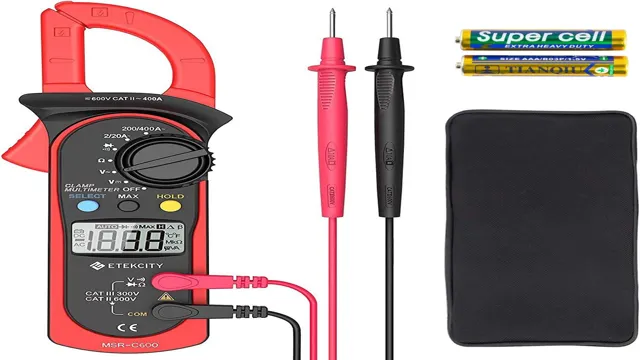Have you ever wondered if your voltage tester is accurate? Whether you’re a professional electrician or a DIY enthusiast, testing your voltage tester is crucial to ensure your safety and the accuracy of your work. A faulty voltage tester could give you a false reading and lead to serious consequences. That’s why it’s essential to know how to test your voltage tester accurately.
It’s like checking your car’s speedometer to make sure you’re not breaking the speed limit. In this blog, we’ll guide you through the different steps to test your voltage tester and provide you with useful tips to get the most accurate results. So, let’s dive into the world of voltage testers and learn how to keep ourselves safe.
Introduction
If you want to ensure that your voltage tester is working properly, then you need to know how to test it. Testing a voltage tester is important because it ensures that it is functioning accurately and safely. To test a voltage tester, you need to use a known, safe voltage source.
First, you need to turn on the voltage tester and make sure it is set to the correct voltage range. Then, touch the voltage source with the tester’s probes to ensure that it accurately reads the voltage and gives an appropriate response. You can also test the continuity function of the voltage tester by verifying its beep or light response when the probes are placed on a known closed circuit.
By testing your voltage tester, you can protect yourself and ensure that your electrical work is accurate and safe. Remember to regularly test your voltage tester to guarantee that it is working correctly.
Overview of Voltage Testers
Voltage testers are invaluable tools that are used to determine the presence or absence of electrical current in a particular circuit. They are designed to help electricians, homeowners, and DIY enthusiasts avoid electrocution and prevent damage to electrical equipment. Voltage testers come in various forms, including simple testers that only indicate the presence of voltage and complex testers that can perform several functions.
One of the most critical features of voltage testers is safety. They are designed to ensure that users can accurately detect voltage and stay safe while working with electricity. Suppose you need to work with electrical systems or troubleshoot any problems related to electricity.
In that case, a voltage tester is a must-have tool in your toolkit to ensure your safety and prevent electrical accidents.

Testing a Voltage Tester With a Voltage Source
If you want to make sure your voltage tester is working properly, one easy way to test it is by using a voltage source. Start by selecting a low voltage source, such as a battery. Next, turn on your voltage tester and hold the leads to the positive and negative terminals of the voltage source respectively.
If the voltage tester is functioning properly, it should display the voltage of the source on its display. It’s important to note that if your voltage tester’s display isn’t showing the correct voltage, it’s likely that the batteries inside the tester need to be replaced. Testing your voltage tester in this way can help ensure that it’s working correctly and is an important step in making sure that you’re making safe electrical measurements.
So, next time you’re not quite sure if your voltage tester is working as it should, give this simple test a try to put your mind at ease.
Step 1: Check the Tester’s Sensitivity
When it comes to ensuring your safety and preventing electrical accidents, using a voltage tester is a must. However, before embarking on any electrical projects, it’s essential to first test your tester to make sure it’s functioning correctly. The first step in testing your voltage tester is to check its sensitivity.
This can be done by using a known voltage source, such as a battery, and testing the tester at various levels of voltage. By doing so, you’ll be able to determine if your tester is sensitive enough to detect low voltage levels consistently. It’s crucial to ensure that your tester is sensitive enough to detect even the smallest voltage levels, as this can prevent potentially dangerous accidents from occurring.
Remember, always be cautious when working with electrical equipment, and never assume that your tester is functioning correctly without testing it first.
Step 2: Check the Tester’s Response Time
When testing a voltage tester with a voltage source, it’s important to check the tester’s response time. The response time refers to how quickly the tester indicates a voltage reading when it’s introduced to a voltage source. This is important because the longer the response time, the more time and effort it takes to use the tester accurately.
Additionally, a longer response time could mean that the voltage is fluctuating quickly, which could be a safety concern. To test the response time, simply introduce the voltage source to the tester and note how quickly the reading appears. A good voltage tester should have a fast response time, indicating that it’s accurately measuring the voltage and minimizing any potential safety risks.
By taking the time to test the response time of your voltage tester, you can ensure that it’s safe and reliable to use.
Step 3: Verify the Tester’s Readings
Now that you’ve tested the voltage tester with a low voltage source, it’s time to move onto verifying the tester’s readings with a high voltage source. Remember to always prioritize safety when handling electricity. Double-check that the voltage source you use is rated for the voltage range you’ll be testing and that you’re using the appropriate safety gear.
Once you’ve connected the voltage tester to the high voltage source, compare the readings to the expected voltage, taking note of any discrepancies. If you notice any irregularities, it’s important to troubleshoot and make any necessary adjustments to the voltage tester. By taking the time to properly verify the tester’s readings, you’ll have confidence in using it for future electrical projects.
Testing a Voltage Tester With a Known Voltage Source
Testing a voltage tester may seem daunting, but it’s actually quite simple with a known voltage source. First, ensure that the voltage source is working correctly by using a multimeter to measure its voltage. Once you have a known voltage reading, touch the voltage tester probes to the source and note the reading.
If the reading matches the known voltage, then your voltage tester is functioning properly. If it doesn’t, then you may need to calibrate or replace the tester. Remember to always wear proper safety equipment and follow electrical safety guidelines when handling voltage sources.
With these steps, you can easily test your voltage tester and ensure that it is providing accurate readings.
Step 1: Set up the Known Voltage Source
When it comes to testing a voltage tester, the first step is to set up a known voltage source. This means using a device that has a consistent voltage output that is already known, such as a battery or a power supply. Once this is set up, you can then use your voltage tester to measure the voltage output and see if it matches the known voltage.
It’s important to make sure that the known voltage source you’re using is within the range that your voltage tester is designed to measure, otherwise you may not get accurate results. By following this simple step, you can ensure that your voltage tester is working correctly and providing accurate readings when you need it.
Step 2: Test the Voltage Tester against the Known Voltage Source
When it comes to testing a voltage tester, it’s essential to test it against a known voltage source. This step is crucial as it ensures that the voltage tester is in good working order and can accurately detect voltage levels. To do this, you’ll need a known voltage source, such as a battery or a power outlet.
Begin the process by turning on the voltage tester and selecting the appropriate setting for the voltage range you want to test. Then, place the tester’s probes against the known voltage source and observe the reading. Ideally, the voltage tester should read the known voltage source’s correct voltage level, indicating that the device is in good working order.
However, suppose the tester is not reading the known voltage level correctly. In that case, it’s an indication that the tester may be faulty and needs to be fixed or replaced. Testing the voltage tester against a known voltage source is a simple yet essential step that should not be skipped.
By doing this, you can rely on your voltage tester to provide accurate readings, ensuring safety and the proper functionality of your electrical equipment.
Conclusion
In conclusion, testing a voltage tester is like testing a superhero’s superpowers. Just like Superman needs his cape and Batman needs his gadgets, a voltage tester needs to be wielded properly and tested regularly to ensure maximum effectiveness. So, go ahead and put your voltage tester to the test, and remember to always stay safe and use your powers for good!”
FAQs
What is a voltage tester and what are its uses?
A voltage tester is a device used to check the presence of electrical voltage in a wire, outlet, or any electrical circuit. It helps in determining whether there is electrical power or not, which is crucial in finding faults in the electrical system.
What are the types of voltage testers available in the market?
There are various types of voltage testers available such as non-contact voltage testers, contact voltage testers, Digital Voltage Testers, and Multi-function Voltage Testers.
How to test a voltage tester?
To test a voltage tester, one can use a known live circuit and check the device’s accuracy by comparing its reading with a multimeter or another known voltage tester.
Is it safe to test a voltage tester on a live circuit?
No, it is not safe to test a voltage tester on a live circuit as it can lead to electrical shock or damage to the device.
Can voltage testers detect voltage in both AC and DC circuits?
It depends on the type of voltage tester. Non-contact voltage testers can detect AC voltage only, while contact voltage testers can detect both AC and DC voltage.
What are the safety precautions to be taken while testing a voltage tester?
Always wear safety gloves and glasses while testing a voltage tester. Ensure that the circuit is switched off and all relevant safety measures are followed.
How to select the right voltage tester for your needs?
Consider the type of circuit you are working on, the voltage range you need to measure, and the accuracy required while selecting a voltage tester. Also, read user reviews and check the specifications before making a purchase.






